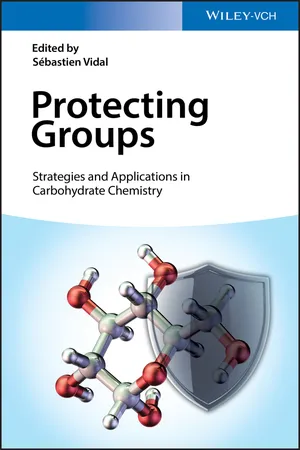
Protecting Groups: Strategies and Applications in Carbohydrate Chemistry
- English
- ePUB (mobile friendly)
- Available on iOS & Android
Protecting Groups: Strategies and Applications in Carbohydrate Chemistry
About This Book
A unique overview of the most important protecting group strategies in carbohydrate chemistry Protecting Groups: Strategies and Applications in Carbohydrate Chemistry provides a detailed account of key strategies and methodologies for the protection of carbohydrates. Divided into two parts, the first focuses on groups that are used best to protect a specific position on a carbohydrate. In the second part, specific carbohydrate residues or compounds are discussed in the context of a specific protecting group strategy used to reach the desired regioisomer. This important book: -Features chapters on protecting groups at the primary and secondary positions of carbohydrates
-Describes protecting group strategies towards sialic acid derivatives, glycofuranoses, sulfated glycosaminoglycans, and cyclodextrins
-Provides information on automated glycan assembly
-Includes a chapter on the industrial scale synthesis of heparin analogs Written by a team of leaders in the field, Protecting Groups: Strategies and Applications in Carbohydrate Chemistry is an indispensable guide for academics and industrial researchers interested in carbohydrate and natural product synthesis, pharmaceutical chemistry, and biochemistry.
Frequently asked questions
Information
1
Protecting Group Strategies in Carbohydrate Chemistry
1.1 Discriminating Different Functionalities on a Carbohydrate Ring
Table of contents
- Cover
- Table of Contents
- Foreword
- Preface
- 1 Protecting Group Strategies in Carbohydrate Chemistry
- 2 Protecting Groups at the Primary Position of Carbohydrates
- 3 Protecting Groups at the Secondary Positions of Carbohydrates
- 4 Regioselective Protection at the Secondary Positions of Carbohydrates with Acyclic Protecting Groups
- 5 Protecting Groups at the Anomeric Position of Carbohydrates
- 6 N‐protecting Groups for 2‐Amino‐2‐deoxy‐glycosides
- 7 One‐pot Multistep Regioselective Protection of Carbohydrates Catalyzed by Acids
- 8 Acyl Migrations in Carbohydrate Chemistry
- 9 De Novo Asymmetric Synthesis of Oligosaccharides Using Atom‐less Protecting Groups
- 10 Protecting Group Strategies for Sialic Acid Derivatives
- 11 Strategies Toward Protection of 1,2‐ and 1,3‐Diols in Carbohydrate Chemistry
- 12 Protecting Group Strategies Toward Glycofuranoses
- 13 Cyclodextrin Chemistry via Selective Protecting Group Manipulations
- 14 Protecting Group Strategies Toward Sulfated Glycosaminoglycans
- 15 Applications of Fluorous and Ionic Liquid Tags in Oligosaccharide Synthesis
- 16 Orthogonally Protected Building Blocks for Automated Glycan Assembly
- 17 Kilogram‐scale Production of Synthetic Heparin Analogs: Some Chemical Considerations
- Index
- End User License Agreement